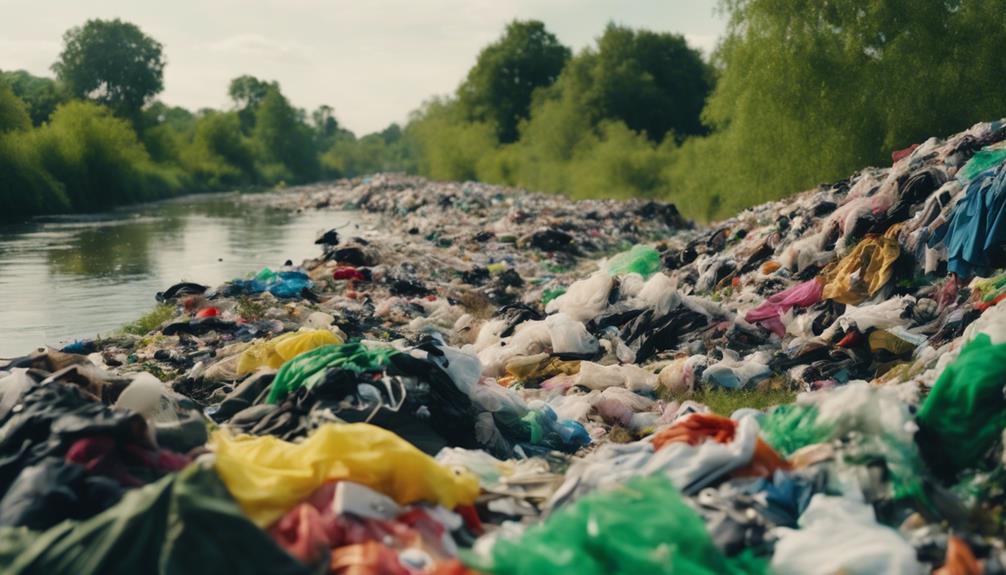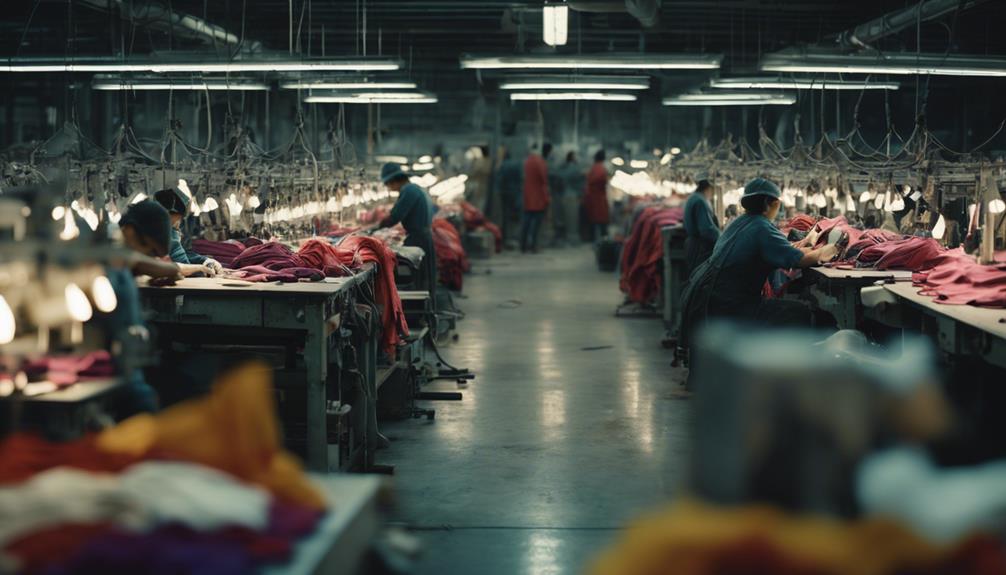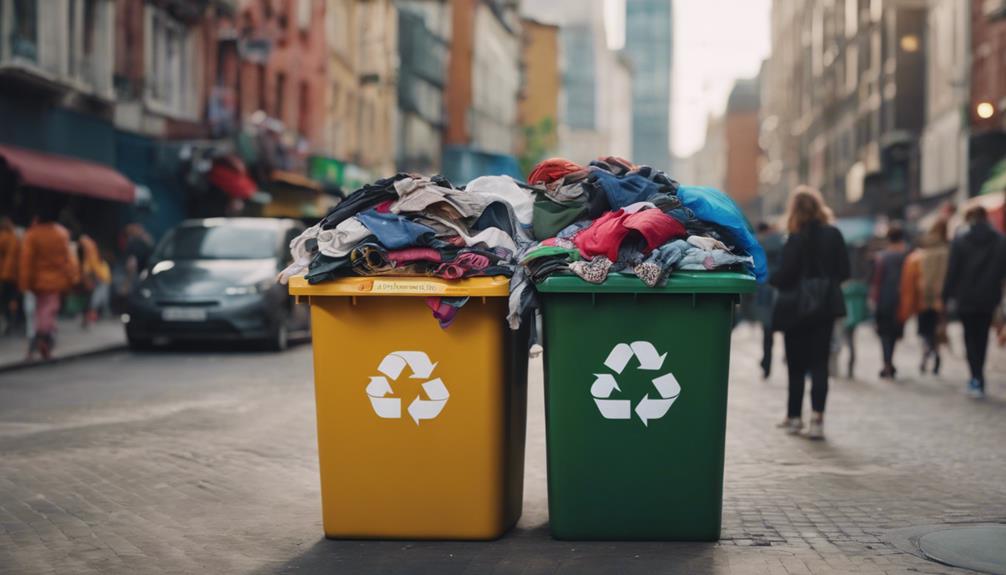H&M’s sustainability claims are often questioned. While they aim to have 100% recycled or sustainably sourced materials by 2030, they have only achieved about 23% so far. The Conscious Collection only features 50% sustainable materials, leading to concerns of greenwashing. The fast fashion practices of H&M contribute to massive waste, with billions of garments being produced that strain resources and pollute the environment. In addition, their ethical labor practices have been criticized, as many workers earn below the poverty line. If you are interested in learning more about the potential impact and future goals of H&M’s sustainability efforts, you may find the following details enlightening.
Key Takeaways
- H&M aims for 100% recycled or sustainably sourced materials by 2030, but only 23% currently meets this standard, raising concerns about greenwashing.
- The Conscious Collection includes only 50% sustainable materials, highlighting limitations in H&M's eco-friendly product offerings.
- Fast fashion significantly contributes to global waste, with H&M producing 3 billion garments in 2019, exacerbating environmental degradation.
- Despite recycling initiatives, only 23% of materials used by H&M are recycled, questioning the effectiveness of their sustainability claims.
H&M's Sustainability Claims
Many people question the authenticity of H&M's sustainability claims, given the considerable discrepancies between their promises and actual practices.
While H&M aims to use 100% recycled or sustainably sourced materials by 2030, only 23% of their materials met this standard by late 2023. This stark contrast undermines their assertion that 84% of their materials are sustainable.
Their Conscious Collection, often marketed as eco-friendly, comprises just 50% sustainable materials, raising concerns about the reality behind their sustainability messaging. Investigations have shown that a staggering 96% of claims in H&M's sustainability report lack substantiation, leading many to accuse the brand of greenwashing.
Despite launching a garment recycling initiative in 2013, critics argue that the actual impact has been minimal, as many collected items don't get recycled as promised. This situation illustrates how H&M's sustainability efforts might serve more as a marketing strategy rather than a true commitment to environmental responsibility.
With fast fashion practices still contributing considerably to global waste, it's crucial to scrutinize H&M's claims and consider whether their approach genuinely supports sustainable fashion or simply perpetuates the cycle of consumption.
Environmental Impact of Fast Fashion

When you consider fast fashion, the environmental impact is hard to ignore.
From carbon emissions to massive textile waste and excessive water usage, the consequences are staggering.
It's essential to recognize how your clothing choices affect the planet and what that means for brands like H&M.
Carbon Emissions Concerns
Fast fashion brands like H&M are major players in the global climate crisis, contributing greatly to carbon emissions and environmental degradation. As you consider your clothing choices, it's crucial to understand the real impact of the fast fashion industry.
Here are some key facts:
- The fast fashion industry contributes to 5% of global greenhouse gas emissions.
- Producing a single t-shirt and jeans requires about 20,000 liters of water.
- H&M produced 3 billion garments in 2019, fueling the overproduction crisis.
- The average person now buys 60% more clothing than a decade ago.
These practices appreciably inflate your carbon footprint, making it essential to reflect on the environmental impact of your purchases.
While H&M promotes sustainable materials and a recycling program, the effectiveness of these initiatives is limited. For instance, it would take 12 years to recycle the clothing produced in just 24 hours.
To make a real difference, consider opting for brands that prioritize sustainability and reduce your consumption of fast fashion. Your choices can help alter the trajectory of our planet's future.
Textile Waste Generation
The staggering amount of textile waste generated by the fast fashion industry reveals a pressing environmental crisis that can't be ignored. Each year, over 92 million tons of textile waste end up in landfills, a problem exacerbated by the production of more than 1 billion garments annually. In 2019 alone, H&M produced a staggering 3 billion items, contributing considerably to global pollution.
In the U.S., about 11.3 million tons of textile waste, which is 85% of all textiles, are discarded each year, largely due to the rapid consumption cycles of fast fashion. You might think recycling is a solution, but H&M's claim of collecting 18,800 tons of clothing for recycling doesn't quite match reality. Investigations show their garments frequently appear in textile waste markets, like those in Ghana.
As the average person now buys 60% more clothing than a decade ago and keeps each item for half as long, the urgency for sustainable clothing options has never been greater. It's clear: to tackle textile waste, we must change our consumption habits and seek out genuinely sustainable alternatives.
Water Usage Issues
Producing a single t-shirt and jeans requires about 20,000 liters of water, highlighting just how unsustainable fast fashion's water usage really is. This staggering amount sheds light on the industry's impact on our water resources.
Here are four key facts to reflect on:
- Fast fashion accounts for around 2.6% of the global water supply usage.
- The average person buys 60% more clothing every year than they did a decade ago.
- Cotton production, a staple in fast fashion, demands immense water—1 kilogram needs about 20,000 liters.
- Each year, around 92 million tons of textile waste ends up in landfills, often representing garments that consumed vast water resources during their creation.
If you're keen on sustainable fashion, explore alternatives like recycled polyester, which uses less water than traditional methods.
Reducing water usage in fashion is essential for tackling environmental issues and ensuring a sustainable future. By making conscious choices in your clothing purchases, you can help alleviate the water crisis and promote a healthier planet.
Labor Rights and Ethical Practices

H&M's commitment to ethical practices faces scrutiny as many workers in its supply chain continue to earn below the poverty line. Despite employing over 1,600 suppliers, primarily in Asia, the brand has struggled to meet its own goal of providing living wages to 850,000 workers. Reports indicate that during the pandemic, a staggering 89% of H&M workers received wages below the international poverty line, raising serious concerns about labor conditions.
While H&M joined the Bangladesh Fire Safety Accord to improve safety after the Rana Plaza disaster, issues like abuse against female workers persist, highlighting ongoing human rights violations in its factories. Although H&M boasts a 71% transparency rating in the Fashion Transparency Index, independent audits reveal significant gaps in ethical practices, with many workers still facing unsafe working conditions.
H&M's partnership with the Fair Wear Foundation aims to enhance worker rights, but the persistent issues show a troubling disconnect between the brand's sustainability claims and the realities faced by its labor force.
For true sustainability, H&M must address these critical labor rights issues and guarantee ethical practices throughout its supply chain.
Animal Welfare Considerations

Animal welfare factors play an essential role in evaluating H&M's sustainability efforts, especially given its mixed track record in sourcing materials ethically. While the brand has made some strides, there are critical points to reflect on:
H&M aligns its animal welfare policy with the Five Freedoms but has been rated 'Not Good Enough' for not certifying all animal fibers by 2025.
The brand uses wool from non-mulesed sheep and sources down and feathers from accredited suppliers, reflecting a commitment to ethical sourcing.
Despite banning fur, angora, and exotic animal skins, H&M still uses leather and exotic hair, raising concerns about the overall animal welfare in its supply chains.
H&M faces criticism for its lack of transparency regarding animal treatment in its supply chain, leading to skepticism about its claims of animal welfare.
While H&M's efforts show promise, the fast fashion model often prioritizes profit over genuine ethical factors.
Consumer Awareness and Behavior

You mightn't realize how much social media shapes your shopping habits, pushing you toward quick buys rather than thoughtful purchases.
As you become more educated about sustainability, it's essential to question the impact of your choices on the environment.
Impact of Social Media
Social media greatly shapes consumer awareness and behavior, often prioritizing fleeting trends over sustainable fashion choices. This influence leads many consumers to overlook the impact of fast fashion, like that of H&M, which continues to thrive despite its sustainability claims.
Here are four key points to reflect on:
- Instant Gratification: Social media encourages you to make quick purchases, often prioritizing trendy items over sustainable clothing.
- Influencer Culture: Influencers glamorize brands like H&M, overshadowing the importance of ethical practices and sustainable alternatives.
- Throwaway Culture: The rapid spread of trends means you might keep clothing for only half as long as you did 15 years ago, contributing to environmental degradation.
- Lack of Awareness: Many consumers remain unaware of the environmental impact of their purchases, making uninformed decisions driven by social media trends.
As a result, while brands tout H&M's sustainability efforts, the pressure of social media ultimately encourages you to purchase items that may not align with those values.
Understanding this influence is vital for making responsible fashion choices.
Education on Sustainability
Understanding the impact of consumer choices on sustainability is essential in combating the fast fashion cycle perpetuated by trends and social media. As a consumer, you play a crucial role in shaping the fashion industry. With individuals buying 60% more clothing than a decade ago, the emphasis on immediate gratification often overshadows sustainability education.
The alarming statistic that the average piece of clothing is worn only seven times before being discarded highlights the urgent need for awareness about the environmental impact of your purchases. When you choose sustainable options, you send a clear message that there's demand for ethical alternatives, which can encourage brands like H&M to adapt their practices.
Social media can be a double-edged sword; while it often promotes rapid consumption, it also has the potential to raise awareness about the negative effects of fast fashion. By educating yourself and others, you empower your community to make informed choices.
As consumers become more aware of sustainability, they can drive significant change in the market, urging brands to prioritize eco-friendly practices. Let's work together to shift the narrative and make responsible fashion choices for a healthier planet.
Recycling Initiatives and Waste Management

H&M's recycling initiatives are often criticized for prioritizing marketing over genuine sustainability, raising doubts about their effectiveness in addressing textile waste. Here are some key points to reflect on:
- It would take 12 years to recycle the clothing produced in just 24 hours.
- Investigations reveal H&M garments among the top labels found in Ghana's textile waste.
- In 2017, 15 tons of defective H&M clothing were incinerated at a power plant.
- Only 23% of materials used by H&M are recycled, contradicting their sustainability claims.
While H&M promotes recycling as a central part of their strategy to combat fast fashion's impact, the reality is more complex. Critics argue these initiatives serve as marketing tools rather than authentic efforts to address the growing issue of textile waste.
With the majority of their clothing ultimately wasted, questions arise about the actual benefits of their recycling programs. As a consumer, it's vital to look beyond the surface and contemplate the broader implications of your purchases.
Are you genuinely supporting sustainability, or are you inadvertently fueling a cycle of waste?
Future Goals for Sustainable Fashion

While concerns about H&M's recycling initiatives persist, the brand is setting ambitious future goals aimed at altering its impact on sustainable fashion. By 2030, H&M plans to use 100% recycled or sustainably sourced materials, along with a target to reduce greenhouse gas emissions by 40%. Additionally, the brand envisions a climate-positive supply chain by 2040, emphasizing its commitment to H&M sustainability.
To achieve these goals, H&M is introducing more sustainable materials, such as organic cotton and Tencel, alongside its ‘Conscious Collection' initiatives. They're also collaborating with NGOs to enhance industry standards. H&M's Head of Sustainability has stressed the importance of moving towards circular fashion models to minimize waste and improve eco-credentials.
Here's a quick overview of H&M's future goals for sustainable fashion:
| Future Goals | Details |
|---|---|
| Materials | 100% recycled or sustainably sourced by 2030 |
| Emission Reduction | Reduce greenhouse gas emissions by 40% by 2030 |
| Climate-Positive Supply Chain | Achieve by 2040 |
With these steps, H&M aims to lead the way in sustainable fashion, but ongoing consumer awareness remains essential.
Frequently Asked Questions
Are H&M Actually Sustainable?
You might question H&M's sustainability claims, especially since their practices often fall short. While they promote sustainable materials, significant challenges remain, raising doubts about their commitment to genuine environmental responsibility and leading to accusations of greenwashing.
Do People Really Care About Sustainable Fashion?
You might care about sustainable fashion, but many prioritize affordability and convenience. While awareness is growing, your purchasing habits often reflect fast fashion trends, overshadowing genuine commitment to sustainability. Education is key to changing this behavior.
What Is the H&M Controversy?
H&M's controversy stems from accusations of greenwashing, with claims of sustainability often unsubstantiated. You might notice their recycling initiatives and eco-friendly collections seem more like marketing tools than genuine efforts to reduce environmental impact.
Is H&M Guilty of Greenwashing?
You might think H&M's sustainability claims are genuine, but evidence suggests otherwise. With low recycling rates and unverified reports, it's hard to ignore the possibility that they're more focused on marketing than true environmental impact.
What Are the Sustainability Practices of H&M Compared to Zara?
H&M and Zara fast fashion truth discovery their sustainability practices differ. H&M has a “Conscious Collection” using organic cotton and recycled materials, while Zara has made commitments to use sustainable fabrics and reduce emissions. Both brands have initiatives, but H&M seems to have a more extensive sustainability focus.
Conclusion
In the end, H&M's sustainability efforts are a double-edged sword. While they promote eco-friendly initiatives, the fast fashion model still casts a long shadow over genuine progress.
As a consumer, your choices shape the industry; you hold the power to demand transparency and ethical practices.
So, don't just follow trends—be a beacon for change in the fashion world. Together, we can turn the tide towards a truly sustainable future, one conscious purchase at a time.









